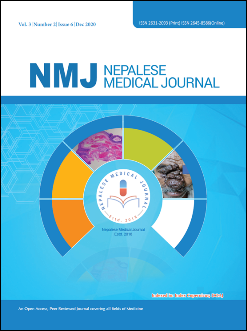Colorectal Polyps: A Histopathological Study in Tertiary Care Center
DOI:
https://doi.org/10.3126/nmj.v4i1.37707Keywords:
Adenoma; Colorectal polyp; Juvenile polypAbstract
Introduction: Gastrointestinal polyps are commonly encountered in the colorectal region. They can be non-neoplastic or neoplastic. Neoplastic polyps include adenomas which are clinically important because of their premalignant nature. The study was carried out to analyze the histomorphological spectrum of polyps; in our institution with special emphasis on adenomatous polyps.
Material and methods: This is a retrospective study done from January 2015 to December 2019 in the Department of Pathology, Dhulikhel Hospital - Kathmandu University Hospital (DH - KUH). Relevant clinical data of the patients were obtained from the histopathological records of the patient from the pathology department and biopsies stained with Haematoxylin and Eosin were studied under the light microscope.
Results: A total of 168 cases of polyp were studied from 125 patients. The most common indication for colonoscopy in patients with polyp was per rectal bleeding. The age of the patient ranged from 2 to 83 years. The rectum was the commonest location. 106(63.1%) of polyps were non-neoplastic and 6(36.9%) of polyps were neoplastic. Juvenile polyp(71;42.3%) was the commonest polyp. Tubular adenoma(55;32.7%) was the commonest neoplastic polyp. The
maximum number of neoplastic polyps were seen in the age group of 51-60years (11;29.7%). Male predominance was seen in neoplastic as well as a non-neoplastic polyp. High grade adenoma(4;6.7%) was more commonly seen in adenomatous polyp >2cm(3;75%) followed by 1-2cm(1;25%) and none in <1cm.
Conclusions: This study gives a fair insight into the distribution of neoplastic and nonneoplastic polyp in the colorectal region. Adenomatous polyps are premalignant.
Downloads
Downloads
Published
How to Cite
Issue
Section
License
Copyright (c) 2021 Dipika Basnet, Ramesh Makaju, Ram Bahadur Gurung, Rachana Dhakal

This work is licensed under a Creative Commons Attribution 4.0 International License.
This license enables reusers to distribute, remix, adapt, and build upon the material in any medium or format, so long as attribution is given to the creator. The license allows for commercial use.
Copyright on any article published by Nepalese Medical Journal is retained by the author(s).
Authors grant Nepalese Medical Journal a license to publish the article and identify itself as the original publisher.
Authors also grant any third party the right to use the article freely as long as its integrity is maintained and its original authors, citation details and publisher are identified.




